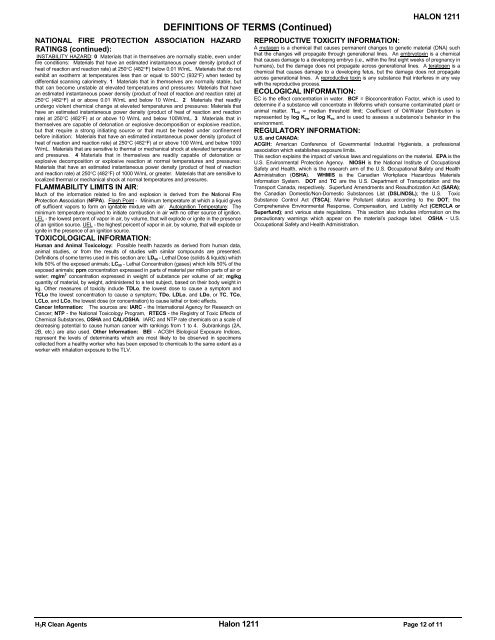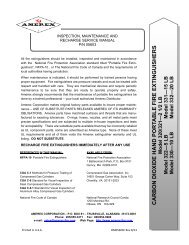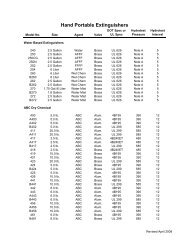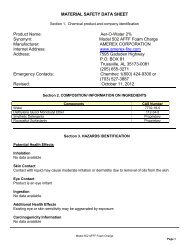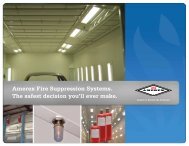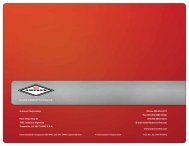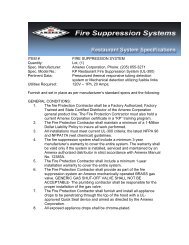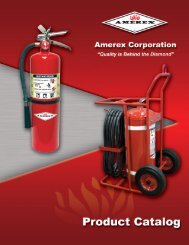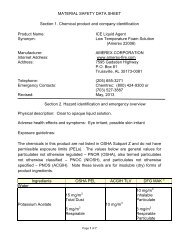halon english
halon english
halon english
- No tags were found...
You also want an ePaper? Increase the reach of your titles
YUMPU automatically turns print PDFs into web optimized ePapers that Google loves.
NATIONAL FIRE PROTECTION ASSOCIATION HAZARDRATINGS (continued):INSTABILITY HAZARD: 0 Materials that in themselves are normally stable, even underfire conditions: Materials that have an estimated instantaneous power density (product ofheat of reaction and reaction rate) at 250C (482F) below 0.01 W/mL. Materials that do notexhibit an exotherm at temperatures less than or equal to 500C (932F) when tested bydifferential scanning calorimetry. 1 Materials that in themselves are normally stable, butthat can become unstable at elevated temperatures and pressures: Materials that havean estimated instantaneous power density (product of heat of reaction and reaction rate) at250C (482F) at or above 0.01 W/mL and below 10 W/mL. 2 Materials that readilyundergo violent chemical change at elevated temperatures and pressures: Materials thathave an estimated instantaneous power density (product of heat of reaction and reactionrate) at 250C (482F) at or above 10 W/mL and below 100W/mL. 3 Materials that inthemselves are capable of detonation or explosive decomposition or explosive reaction,but that require a strong initiating source or that must be heated under confinementbefore initiation: Materials that have an estimated instantaneous power density (product ofheat of reaction and reaction rate) at 250C (482F) at or above 100 W/mL and below 1000W/mL. Materials that are sensitive to thermal or mechanical shock at elevated temperaturesand pressures. 4 Materials that in themselves are readily capable of detonation orexplosive decomposition or explosive reaction at normal temperatures and pressures:Materials that have an estimated instantaneous power density (product of heat of reactionand reaction rate) at 250C (482F) of 1000 W/mL or greater. Materials that are sensitive tolocalized thermal or mechanical shock at normal temperatures and pressures.FLAMMABILITY LIMITS IN AIR:Much of the information related to fire and explosion is derived from the National FireProtection Association (NFPA). Flash Point - Minimum temperature at which a liquid givesoff sufficient vapors to form an ignitable mixture with air. Autoignition Temperature: Theminimum temperature required to initiate combustion in air with no other source of ignition.LEL - the lowest percent of vapor in air, by volume, that will explode or ignite in the presenceof an ignition source. UEL - the highest percent of vapor in air, by volume, that will explode orignite in the presence of an ignition source.TOXICOLOGICAL INFORMATION:Human and Animal Toxicology: Possible health hazards as derived from human data,animal studies, or from the results of studies with similar compounds are presented.Definitions of some terms used in this section are: LD 50 - Lethal Dose (solids & liquids) whichkills 50% of the exposed animals; LC 50 - Lethal Concentration (gases) which kills 50% of theexposed animals; ppm concentration expressed in parts of material per million parts of air orwater; mg/m 3 concentration expressed in weight of substance per volume of air; mg/kgquantity of material, by weight, administered to a test subject, based on their body weight inkg. Other measures of toxicity include TDLo, the lowest dose to cause a symptom andTCLo the lowest concentration to cause a symptom; TDo, LDLo, and LDo, or TC, TCo,LCLo, and LCo, the lowest dose (or concentration) to cause lethal or toxic effects.Cancer Information: The sources are: IARC - the International Agency for Research onCancer; NTP - the National Toxicology Program, RTECS - the Registry of Toxic Effects ofChemical Substances, OSHA and CAL/OSHA. IARC and NTP rate chemicals on a scale ofdecreasing potential to cause human cancer with rankings from 1 to 4. Subrankings (2A,2B, etc.) are also used. Other Information: BEI - ACGIH Biological Exposure Indices,represent the levels of determinants which are most likely to be observed in specimenscollected from a healthy worker who has been exposed to chemicals to the same extent as aworker with inhalation exposure to the TLV.DEFINITIONS OF TERMS (Continued)HALON 1211REPRODUCTIVE TOXICITY INFORMATION:A mutagen is a chemical that causes permanent changes to genetic material (DNA) suchthat the changes will propagate through generational lines. An embryotoxin is a chemicalthat causes damage to a developing embryo (i.e., within the first eight weeks of pregnancy inhumans), but the damage does not propagate across generational lines. A teratogen is achemical that causes damage to a developing fetus, but the damage does not propagateacross generational lines. A reproductive toxin is any substance that interferes in any waywith the reproductive process.ECOLOGICAL INFORMATION:EC is the effect concentration in water. BCF = Bioconcentration Factor, which is used todetermine if a substance will concentrate in lifeforms which consume contaminated plant oranimal matter. TL m = median threshold limit; Coefficient of Oil/Water Distribution isrepresented by log K ow or log K oc and is used to assess a substance’s behavior in theenvironment.REGULATORY INFORMATION:U.S. and CANADA:ACGIH: American Conference of Governmental Industrial Hygienists, a professionalassociation which establishes exposure limits.This section explains the impact of various laws and regulations on the material. EPA is theU.S. Environmental Protection Agency. NIOSH is the National Institute of OccupationalSafety and Health, which is the research arm of the U.S. Occupational Safety and HealthAdministration (OSHA). WHMIS is the Canadian Workplace Hazardous MaterialsInformation System. DOT and TC are the U.S. Department of Transportation and theTransport Canada, respectively. Superfund Amendments and Reauthorization Act (SARA);the Canadian Domestic/Non-Domestic Substances List (DSL/NDSL); the U.S. ToxicSubstance Control Act (TSCA); Marine Pollutant status according to the DOT; theComprehensive Environmental Response, Compensation, and Liability Act (CERCLA orSuperfund); and various state regulations. This section also includes information on theprecautionary warnings which appear on the material’s package label. OSHA - U.S.Occupational Safety and Health Administration.H 3 R Clean Agents Halon 1211 Page 12 of 11


